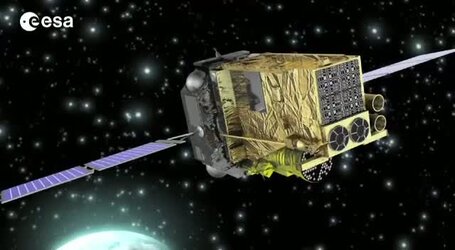Notes for Editors
Integral was launched on 17 October 2002 by a Proton/Blok-DM rocket from Baikonur, Kazakhstan. It operates in an elliptical 72-hour orbit around Earth.
Equipped with two gamma-ray telescopes, an X-ray monitor and an optical camera, all four of Integral’s instruments point simultaneously at the same region of the sky to make complementary observations of high-energy sources.
With an initial mission duration of two years, it continues to operate very successfully after ten years and a further extension beyond 31 December 2014 is under consideration.
Animation captions
Galactic Centre through Integral’s eyes:
Download movie
The central region of our Milky Way, the Galactic Bulge, is a rich host of variable high-energy X-ray and gamma-ray sources.
After a short introduction illustrating Integral’s place in ESA’s fleet of astronomy and astrophysics satellites, the movie looks inside the central bulge to reveal these dynamic sources, which include X-ray binary systems with either a black hole or a neutron star, pulsars and remnants of supernova explosions.
A number of these sources only shine brightly for a limited period of time – in some cases, they appear as a sudden bright flash and disappear shortly afterwards, whereas others are more persistent. The effect of this constantly changing environment gives the Galactic Bulge the appearance of a dramatic cosmic light show.
Zooming back out of the Milky Way shows a bird’s eye view of the known gamma and hard X-ray sources in our Milky Way.
The movie concludes with a stunning fly-through of the central part of the Galactic Bulge before returning to our Solar System and the orbit of Integral around Earth.
Credits: ESA–C. Carreau & E. Kuulkers
Integral science highlights:
Download movie
A journey through some of Integral’s key science highlights. From rare breeds of binary stars and pulsars with extraordinary magnetic fields, to the annihilation of matter with antimatter and the feeding habits of black holes, Integral has been uncovering the secrets of the most energetic phenomena in the Universe.
This slideshow of artist impressions was first released on Monday as our Space Science Image of the Week.
Credits: ESA–C. Carreau.
For further information, please contact:
Markus Bauer
ESA Science and Robotic Exploration Communication Officer
Tel: +31 71 565 6799
Mob: +31 61 594 3 954
Email: markus.bauer@esa.int
Christoph Winkler
ESA Integral Project Scientist
Email: Christoph.Winkler@esa.int















 Germany
Germany
 Austria
Austria
 Belgium
Belgium
 Denmark
Denmark
 Spain
Spain
 Estonia
Estonia
 Finland
Finland
 France
France
 Greece
Greece
 Hungary
Hungary
 Ireland
Ireland
 Italy
Italy
 Luxembourg
Luxembourg
 Norway
Norway
 The Netherlands
The Netherlands
 Poland
Poland
 Portugal
Portugal
 Czechia
Czechia
 Romania
Romania
 United Kingdom
United Kingdom
 Slovenia
Slovenia
 Sweden
Sweden
 Switzerland
Switzerland










































